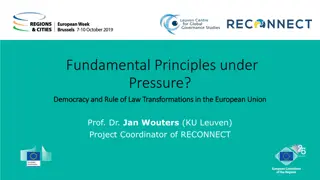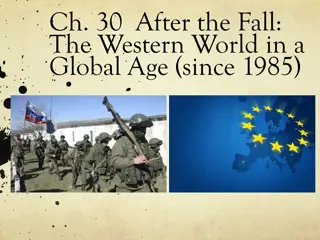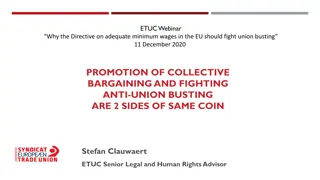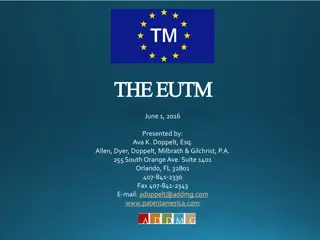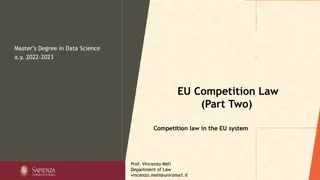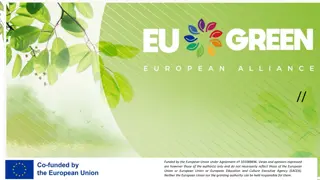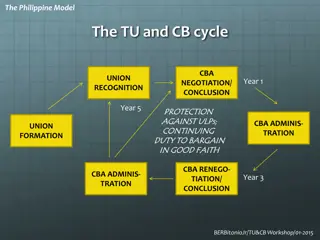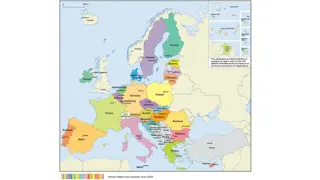Dimensions of Membership in the European Union
The formal and substantive dimensions of membership in the European Union are outlined, including the criteria for accession and withdrawal. Formal criteria involve unanimity, consent of the European Parliament, and ratification of agreements, while substantive requirements focus on a state's commitment to EU values. The process for withdrawal is also detailed, highlighting the negotiation of agreements and cessation of treaty application. Understanding these dimensions is crucial for countries seeking to join or leave the EU.
Download Presentation

Please find below an Image/Link to download the presentation.
The content on the website is provided AS IS for your information and personal use only. It may not be sold, licensed, or shared on other websites without obtaining consent from the author.If you encounter any issues during the download, it is possible that the publisher has removed the file from their server.
You are allowed to download the files provided on this website for personal or commercial use, subject to the condition that they are used lawfully. All files are the property of their respective owners.
The content on the website is provided AS IS for your information and personal use only. It may not be sold, licensed, or shared on other websites without obtaining consent from the author.
E N D
Presentation Transcript
Membership: Formal and Substantive Dimensions Paul Craig
Formal Dimension: Accession Formal criteria for membership: Article 49 TEU Any European State which respects the values referred to in Article 2 and is committed to promoting them may apply to become a member of the Union. The European Parliament and national Parliaments shall be notified of this application. The applicant State shall address its application to the Council, which shall act unanimously after consulting the Commission and after receiving the consent of the European Parliament, which shall act by a majority of its component members. The conditions of eligibility agreed upon by the European Council shall be taken into account. The conditions of admission and the adjustments to the Treaties on which the Union is founded, which such admission entails, shall be the subject of an agreement between the Member States and the applicant State. This agreement shall be submitted for ratification by all the contracting States in accordance with their respective constitutional requirements
Formal Dimension: Accession Article 49: Noteworthy Features: Formal pre-condition: unanimity required to join -- Council voting to be unanimous; plus consent of EP Formal pre-condition: terms of accession to be determined between acceding state and existing MS Formal pre-condition: agreement containing terms of accession to be ratified by MS in accord with their constitutional requirements Substantive pre-condition: commitment to EU values inArticle 2 TEU Substantive precondition: linkage between Art 49 and Art 2 important for the legitimacy of CJEU intervention in relation to rule of law backsliding, see below Substantive pre-condition necessary but not sufficient for membership: a state may apply , if it complies with these values, but no guarantee that it will be accepted
Formal Dimension: Withdrawal Formal criteria for ceasing to be a member:Article 50 TEU 1. Any Member State may decide to withdraw from the Union in accordance with its own constitutional requirements. 2. A Member State which decides to withdraw shall notify the European Council of its intention. In the light of the guidelines provided by the European Council, the Union shall negotiate and conclude an agreement with that State, setting out the arrangements for its withdrawal, taking account of the framework for its future relationship with the Union. That agreement shall be negotiated in accordance with Article 218(3) of the Treaty on the Functioning of the European Union. It shall be concluded on behalf of the Union by the Council, acting by a qualified majority, after obtaining the consent of the European Parliament. 3. The Treaties shall cease to apply to the State in question from the date of entry into force of the withdrawal agreement or, failing that, two years after the notification referred to in paragraph 2, unless the European Council, in agreement with the Member State concerned, unanimously decides to extend this period. 4. For the purposes of paragraphs 2 and 3, the member of the European Council or of the Council representing the withdrawing Member State shall not participate in the discussions of the European Council or Council or in decisions concerning it. A qualified majority shall be defined in accordance withArticle 238(3)(b) of the Treaty on the Functioning of the European Union. 5. If a State which has withdrawn from the Union asks to rejoin, its request shall be subject to the procedure referred to inArticle 49.
Formal Dimension: Withdrawal Article 50: Noteworthy Features Formal pre-condition: notice from MS seeking to withdraw in accord with its constitutional requirements Formal pre-condition: if there is a Withdrawal Agreement, WA, only needs QMV (Compare with accession, unanimity requirement) Substantive pre-condition: bifurcation of the WA and future trade relations, FTR. Bifurcation logical/rational: Full FTR takes circa 5 years to conclude, cannot keep a state that seeks to withdraw in the EU for 5 years until the FTR done. Substantive pre-condition: bifurcation problematic: withdrawing state may have thought through nature of its FTR before deciding to invoke Art 50, but probably not have done so, in which case any Brexit almost inevitably a blind Brexit attested to by 100% of the current empirical evidence , ie the UK leaving the EU. Pretty much all executive and parliamentary discourse pre-exit (Lancaster House, Government White Paper, Florence, Mansion House, Chequers) about the trade dimension, even though this was not on the table for discussion during negotiation of the WithdrawalAgreement
Formal Dimension: Accession and Withdrawal Compare and Contrast, Accession and Withdrawal: Two Dimensions to both, agreement to get in/out, trade terms thereafter Accession: Simpler: Prima Facie Prix Fix Deal Accession Agreement: predicated on default position that acceding state complies with entire acquis as pre-condition of membership Trade Dimension: set by EU Treaty rules on single market, competition, state aids etc Voting: Rationale for unanimity Withdrawal: More Complex: Prima Facie Ala Carte in both Respects WithdrawalAgreement: no boiler plate on which to rely, has to be crafted afresh Trade Agreement: no a priori reason why there should be any particular trade deal between EU and withdrawing state, range of possibilities, subject to negotiation Voting: Rationale for QMV
Substantive Dimension: Membership Membership consequences for the state qua Member State when its application is accepted. The consequences take the form of rights, powers and duties. These are not however conceptually uniform. Consider, by way of example, the duties that inhere in membership. We can distinguish between the following three types of duty: is undertaken by the acceding state, and has
Substantive Dimension: Membership Discrete primary duties: these capture much of the core substance of EU membership, such as, for example, the duties associated with the four freedoms and the single market, the duties associated with the state aid regime and the duties flowing from EU environmental rules. General primary duties: compliance with, for example,Art 2 TEU The Union is founded on the values of respect for human dignity, freedom, democracy, equality, the rule of law and respect for human rights, including the rights of persons belonging to minorities. These values are common to the Member States in a society in which pluralism, non-discrimination, tolerance, justice, solidarity and equality between women and men prevail
Substantive Dimension: Membership Discrete secondary remedial duty: exemplified and epitomized byArt 19 TEU: 1. The Court of Justice of the European Union shall include the Court of Justice, the General Court and specialised courts. It shall ensure that in the interpretation and application of the Treaties the law is observed. 2. Member States shall provide remedies sufficient to ensure effective legal protection in the fields covered by Union law. General secondary duties: exemplified and epitomized byArt 4(3) TEU: Pursuant to the principle of sincere cooperation, the Union and the Member States shall, in full mutual respect, assist each other in carrying out tasks which flow from the Treaties. The Member States shall take any appropriate measure, general or particular, to ensure fulfilment of the obligations arising out of the Treaties or resulting from the acts of the institutions of the Union. The Member States shall facilitate the achievement of the Union's tasks and refrain from any measure which could jeopardise the attainment of the Union's objectives
Substantive Dimension: Membership Linkage between primary and secondary duties of membership: powerfully exemplified by CJEU case on rule of law backsliding by MSs. Thus, Article 2 TEU provides the locus for the primary duty of compliance with the rule of law; Article 19(2) provides the remedial dimension: See, eg, Case C-64/16 Portuguese Judges case, [42]: The guarantee of independence, which is inherent in the task of adjudication is required not only at EU level as regards the Judges of the Union and the Advocates-General of the Court of Justice, as provided for in the third subparagraph of Article 19(2) TEU, but also at the level of the Member States as regards national courts. See, eg, Case C-619/18 Commission v Poland [58]: That requirement that courts be independent, which is inherent in the task of adjudication, forms part of the essence of the right to effective judicial protection and the fundamental right to a fair trial, which is of cardinal importance as a guarantee that all the rights which individuals derive from EU law will be protected and that the values common to the Member States set out inArticle 2 TEU, in particular the value of the rule of law, will be safeguarded.
Substantive Dimension: Membership Membership attaches to the Member State, and has consequences for citizens thereof For example: Benefits of EU citizenship: relationship between Membership and EU Citizenship: Not a priori: perfectly possible to have a Community with Member States thereof, without necessarily havingArts 18-22 TFEU on EU citizenship Not fortuitous: driven by desire to thicken political and civic bond created by the EU Benefits of direct effect: relationship between Membership and Direct Effect: Not a priori: perfectly possible to have Community with MSs without direct effect and the rights that attach thereto Not fortuitous: driven by desire to render more effective enforcement of EU law and to drive home the idea that EEC was not merely an order of Member States like other international treaties
Substantive Dimension: Membership Relationship between Need to be clear about meaning of DI Daniel Thym correctly distinguishes between three models of DI: multiple speeds ; federal core Europe ; and flexibility la carte . Multiple speeds model key characteristic: all Member States will be bound by the final objective, whose realisation is phased in gradually . Therefore multiple speeds means differentiation as a transitional phenomenon in response to objective distinctions between MS, in terms of stage of economic development etc Membership and Differentiated Integration:
Substantive Dimension: Membership Relationship between Meaning of DI Federal core Europe model key characteristic: to retain the momentum in support of closer integration and to forge ahead with those who are willing to do so , through, eg, Treaty reform plus opt- outs if necessary, enhanced cooperation or Treaties outside the Lisbon framework Flexibility la carte model key characteristic: reject the federal vision and emphasise a principled freedom of the Member States to decide upon the degree of participation in the EU, mirroring intergovernmental international relations theory. Membership and Differentiated Integration:
Substantive Dimension: Membership Relationship between First Principles: Does the very concept of membership entail uniformity across all terrains? No, there is no a priori reason why membership has to entail absolute uniformity of application across all domains of EU law; many organizations have different terms of membership with different obligations attaching thereto. Does the very concept of membership entail differentiated integration? No, there is no a priori reason why membership has to entail any differentiated integration; many organizations function with flat rights and obligations that pertain to all Membership and Differentiated Integration:
Substantive Dimension: Membership Relationship between Membership and Differentiated Integration: Factors circumscribing uniform conceptions of membership and driving differentiated integration: Other things being equal, the greater the substantive reach of Treaty regime, and the greater the number of MS, the greater incentive for some differentiated integration Other things being equal, the more demanding/far-reaching the nature of the EU obligations, and the more intrusive on national sovereignty, the greater the incentive for/pressure for, some special treatment by some Member States, see, eg, EMU,AFSJ
Substantive Dimension: Membership Relationship Integration: Factors circumscribing differentiated integration and driving commonality in conceptions/terms/results of membership: Decisional: to satisfy formal legitimacy of such provisions Decisional: DI embodied in Treaty/Treaty amendment, UK opt-outs etc Decisional: DI embodied in EU legislation, result of decisional choice in accord with rules for making of such decisions, provided that the rules thus made are consistent with the empowering Treaty provisions pursuant to which the regulation, directive etc is made. Decisional: DI result of practice, power politics, inadequate enforcement etc, clearly questionable in terms of formal legitimacy between Membership and Differentiated
Substantive Dimension: Membership Relationship between Membership and Differentiated Integration: Factors circumscribing differentiated integration and driving commonality in conceptions/terms/results of membership: Functional: realization of negative externalities created by DI: Functional: realization that too much latitude to MS, and too much difference in application of relevant rules, can lead to significant negative consequences, eg EMU, change in EU rules post financial crisis, upgrading of supranational component, limits to MS discretion, and limits to any DI in this area. Functional: related but distinct, the idea DI can lead to negative spillover, differential treatment allowed in one MS can have affects on application of regulatory provisions in other MS, part of drive for maximal rather than minimal harmonization; interesting link with initial rationale for creation of EU, to deal with externalities created by state regulatory activity
Substantive Dimension: Membership Relationship between Membership and Differentiated Integration: Factors circumscribing differentiated conceptions/terms/results of membership: Normative: existence of normative constraints on DI, flowing from conceptions of membership Normative: central idea here is that different parts of the EU are not hermetically sealed one from another; a danger inherent in DI is that it infringes on precepts of equality, wherein the MSs share the benefits/burdens of membership, DI can therefore, depending on the form that it takes, generate free rider problems Normative: central idea here is that cannot allow DI, de jure or de facto, to impinge on common core of EU values; content of this common core may be contestable, but that does not undermine the point being made here; so DI that seriously impinged on Art 2 TEU values would not be acceptable, as exemplified by problems with Hungary, Poland; so also DI that undermined central core content of single market and level playing field would not be acceptable. integration and driving commonality in
Substantive Dimension: Membership Logic of Chaos (is Order): Status Quo Substantive Content of EU Membership can vary depending, inter alia, on the degree of DI Precise Content of EU Membership in any single MS, and as between MS, dynamic, will vary across time Common institutional and decisional rules continue to apply, subject to any ad hoc amendment thereof demanded by DI Messy but stable Logic of Order (is Chaos): Possible Change Formalize differing degrees of DI, through concentric circles, or Piris type suggestion Precise content of EU membership formalized to greater degree depending on the placing of the state within the pattern of pre-ordained concentric circles Change institutional and decisional rules to reflect different types of EU membership, eg a separate European Parliament, Piris type suggestions Neater but unstable
Substantive Dimensions: Withdrawal Article 50: Conception of Membership Wightman: conceptual underpinnings of Article 50 -- voluntariness and state sovereignty [50] Article 50(1) TEU provides that any Member State may decide to withdraw from the European Union in accordance with its own constitutional requirements. It follows that the Member State is not required to take its decision in concert with the other Member States or with the EU institutions. The decision to withdraw is for that Member State alone to take, in accordance with its constitutional requirements, and therefore depends solely on its sovereign choice . [56] Article 50 TEU pursues two objectives, namely, first, enshrining the sovereign right of a Member State to withdraw from the European Union and, secondly, establishing a procedure to enable such a withdrawal to take place in an orderly fashion.
Substantive Dimensions: Withdrawal Wightman: conceptual underpinnings ofArticle 50 -- voluntariness and state sovereignty [57] the sovereign nature of the right of withdrawal enshrined in Article 50(1) TEU supports the conclusion that the Member State concerned has a right to revoke the notification of its intention to withdraw from the European Union, for as long as a withdrawal agreement concluded between the European Union and that Member State has not entered into force or, if no such agreement has been concluded, for as long as the two-year period laid down in Article 50(3) TEU, possibly extended in accordance with that provision, has not expired. [63] As is apparent from Article 49 TEU, which provides the possibility for any European State to apply to become a member of the European Union and to which Article 50 TEU, on the right of withdrawal, is the counterpart, the European Union is composed of States which have freely and voluntarily committed themselves to those values, and EU law is thus based on the fundamental premiss that each Member State shares with all the other Member States, and recognises that those Member States share with it, those same values . [65] given that a State cannot be forced to accede to the European Union against its will, neither can it be forced to withdraw from the European Union against its will.
Substantive Dimensions: Future Relations Negotiation of Treaty concerning future relations post Brexit. By definition the UK no longer a MS, although bound by EU law during the transitional period. Implications of absence of membership: Procedural: it is very likely that the 27 MS will continue to show unity behind the new negotiating team of Michel, von der Leysen and Barnier, as they did behind the old negotiating team of Tusk, Juncker and Barnier; no bilaterals etc Substantive: Commission UKTF briefings contain a wealth of material indicating Commission thinking about the nature of the future trading relationship. Space precludes detailed discussion. Suffice it to say the following: A central theme is the difference between membership of the EU single market and a free trade deal, and the difference between membership of the EU customs union and a bespoke customs deal crafted for the EU and UK. The degree of difference will be affected, inter alia, by the extent to which there is a level playing field between the UK and EU in relation to matters to matters such as environmental, social and labour policy, and the costs flowing therefrom. It will also be affected by the degree of regulatory autonomy sought by the UK. Thus, other things being equal the greater the divergence in these respects, the less access there will be to EU markets.





